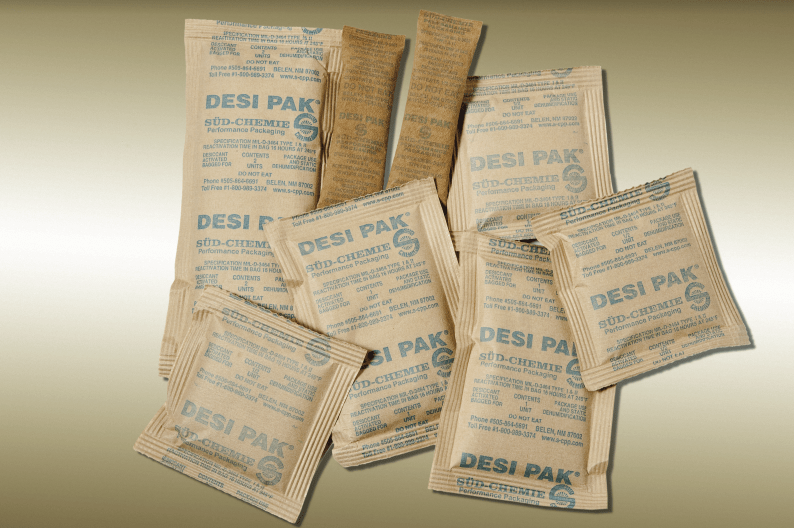Mil-Spec Desiccant Products From Edco Supply Corporation
Mil-D-3464E is the U.S. military specification for silica gel and clay desiccants. It includes requirements for the desiccant performance and packaging, as well as specific test procedures. Desiccant Bags are desiccants that are packaged in porous materials such as Kraft Paper or Tyvek. Desiccant bags absorb moisture, odors and chemicals to preserve and protect your products such as semiconductors, electronics, cartons of food, and all types of machinery.
Benefits of Desiccant Bags
- Keeps products fresh: The shipping process can take a toll on goods, especially during extended journeys or when sending items overseas. Feel confident that your products will arrive in excellent condition and meet your customers’ expectations.
- Exceptional moisture control: Our products’ proven ability to absorb water and humidity will keep your goods dry, even in damp environments. They can even protect the items after they arrive at your customer’s destination if they need to store them briefly.
- Multiple uses: Our Mil-D-3464E desiccant packets are ideal for various industries and applications. In addition to protecting products such as semiconductors, food cartons, electronics and machinery, they can combat moisture in workplace areas like desk drawers, garbage cans, tool drawers and file cabinets. Household uses include photograph storage boxes, wet boots and shoes, containers holding collectibles and technology storage cases.
Measuring Desiccant Units
A “Unit” is a military specification term for measuring the amount of desiccant you need when packaging materials. The term unit is a quantity of desiccant, which will absorb a set percentage of its weight at certain levels of humidity.
Mil-D-3464E defines a “Unit” as the amount of desiccant needed to absorb:
- 3 grams of water at 20% RH, 25˚C, and
- 6 grams of water at 40% RH, 25˚C.
- A unit is also roughly equivalent to one ounce.
Desiccant Mil-Spec Classifications
Under MIL-D-3464E there are three classifications of desiccant:
- Type I bags meet the Mil-D requirements for absorption, reactivation, dusting, and durability.
- Type II bags meet all the requirements of Type I, plus a tighter dusting spec. (Type II bags are “low dust.”)
- Type III bags meet all of the requirements of Type I, plus resistance to hot water.
The “dust test” is a measure of how much dust escapes through the bag material. The specification for dusting is:
- Type I and Type III: Less than 5.0 mg
- Type II: Less than 0.5 mg
All of the desiccant sold at Edco meets Type I and type II requirements.
Mil-Spec Desiccant Markings and Labels
Mil-D-3464E specifies the information that must be included in the print. If a bag does not contain this information, it is not a Mil-D bag:
- Nomenclature: Desiccant, Activated, Bagged For Package Use and Static Dehumidification
- Specification: MIL-D-3464
- Type I, II, or III as applicable
- Manufacturer’s designation
- Unit Content
- Reactivation temperature in bag ____ºF
- Reactivation time ____ hours
- Manufacturer’s name and address
Desiccant Reuse and Reactivation
In order to reuse the desiccant bags, they can be placed in a circulating oven and baked to drive off the moisture. After reactivation, the bags must be able to pass a durability test (drop test), to ensure that the seal strengths are not compromised. The bags must also retain 90% of their original adsorption capacity. All Mil-D products can be reactivated. Instructions including baking temperatures and times are printed on each Mil-D bag. We recommend reactivating clay desiccant a maximum of 5 times.
FAQs for Desiccant Products
What is a desiccant?
A desiccant is a hygroscopic substance that induces or sustains a state of dryness (desiccation) in its local vicinity in a moderately well-sealed container. Commonly encountered pre-packaged desiccants are solids, and work through absorption or adsorption of water, or a combination of the two. Pre-packaged desiccant is most commonly used to remove excessive humidity that would normally degrade or even destroy products sensitive to moisture. Desiccants are also well-known for preventing the formation of mold within your packages. Edco primarily supplies desiccants made from montmorillonite clay and silica gel.
What is a desiccant “unit”?
In desiccant terminology, a “unit” is the quantity of desiccant required to meet the U.S. Military’s specification (MIL-D-3464E) for packaged desiccant products. Under this specification, a unit is the quantity of desiccant which will adsorb 3.00 grams of water vapor at 20% relative humidity or 6.00 grams of water vapor at 40% relative humidity at 77°F (25°C).
How do you effectively use desiccant packs?
In order to achieve the best levels of protection, desiccants function best within a sealed moisture bag or container. Generally speaking, humidity indicator cards are placed inside the container to demonstrate humidity levels clearly. The indicator cards also show when the desiccant needs replacing.
How much desiccant do I need?
The amount of desiccant that you require really depends on a number of factors, such as:
- What items need protecting?
- Which kind of desiccant will you be using?
- How long does the product need to be protected?
- What is the volume of air space to be desiccated?
- Is there going to be moisture surrounding the package?
- What are the atmospheric conditions?
Temperature and relative humidity are the critical components that make up atmospheric conditions. Both of these factors relate to when and where the product was sealed, as well as the relevant condition in shipment and storage.
What desiccant bag sizes are available from Edco Supply Corporation?
There are a number of sizes available when it comes to desiccant bags. The standard sizes are the following: 1/6, 1/3, 1/2, 1, 2, 4, 8, 16 and 80 units. As a guide, one unit is roughly one ounce of desiccant material.
Which industries commonly use desiccants?
The most popular consumers of desiccants are the industrial, electrical component packaging and pharmaceutical industries. This includes engineering firms, and many military packaging contracts. However, a diverse set of industries can find great uses for desiccant protective packaging products.


